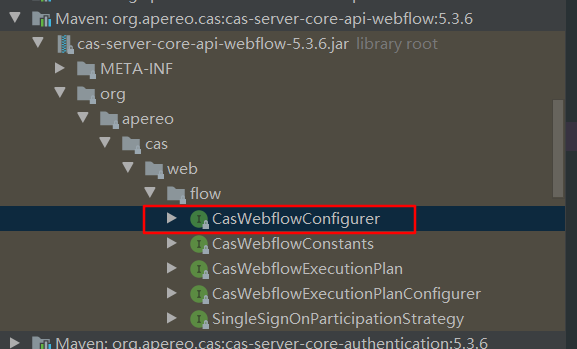通过Rest接口实现CAS单点登录
打算做客户端通过rest接口来进行单点登录,这样可以方便的让任意客户端来自定义登录页面的样式等。
通过官网的说明,可以获取到TGT,通过TGT获取到ST,可以实现服务访问,但是登录成功后,访问其他的SSO系统,由于server域中并没有TGC的cooki保存,因而无法实现登录。
初步设想是rest登录成功后,附带地址参数重定向至服务端,让服务端进行了cooki保存,后续其他的SSO系统就可以照常接入了。
1.导入依赖
不导入依赖的话源码看不到,overlays的这种方式确实挺恶心
<!--开启rest认证--> <dependency> <groupId>org.apereo.cas</groupId> <artifactId>cas-server-support-rest</artifactId> <version>${cas.version}</version> </dependency> <!--自定义效验的依赖--> <dependency> <groupId>org.apereo.cas</groupId> <artifactId>cas-server-core-authentication</artifactId> <version>${cas.version}</version> </dependency> <dependency> <groupId>org.apereo.cas</groupId> <artifactId>cas-server-core-authentication-api</artifactId> <version>${cas.version}</version> </dependency> <dependency> <groupId>org.apereo.cas</groupId> <artifactId>cas-server-core-webflow</artifactId> <version>${cas.version}</version> </dependency> <dependency> <groupId>org.apereo.cas</groupId> <artifactId>cas-server-core-webflow-api</artifactId> <version>${cas.version}</version> </dependency> <!--登陆时的效验--> <dependency> <groupId>org.apereo.cas</groupId> <artifactId>cas-server-core-cookie</artifactId> <version>${cas.version}</version> </dependency> <dependency> <groupId>org.apereo.cas</groupId> <artifactId>cas-server-support-actions</artifactId> <version>${cas.version}</version> </dependency>
2. 启动loginflow分析
cas登录使用了webflow, 所以先去webflow的相关包看看。
找到如图的casWebflowConfigurer,webflow的配置接口。
/** * This is {@link CasWebflowConfigurer}. * * @author Misagh Moayyed * @since 5.0.0 */ public interface CasWebflowConfigurer extends Ordered { /** * Main login flow id. */ String FLOW_ID_LOGIN = "login"; /** * Main logout flow id. */ String FLOW_ID_LOGOUT = "logout";找找实现类,发现 DefaultLoginWebflowConfigurer,应该就是这玩意,进去看看。
存在一个如下的初始化方法,debug看看。感觉这里每一步都值得详细看看。
@Override protected void doInitialize() { //1.获取加载login-webflow.xml后的webflow final Flow flow = getLoginFlow(); if (flow != null) { //2.给flow中添加初始化的FlowActions createInitialFlowActions(flow); //3.创建全局异常处理的节点 createDefaultGlobalExceptionHandlers(flow); //4.创建登录结束的节点 createDefaultEndStates(flow); //5.添加描述节点 createDefaultDecisionStates(flow); //6.添加执行节点 createDefaultActionStates(flow); createDefaultViewStates(flow); createRememberMeAuthnWebflowConfig(flow); setStartState(flow, CasWebflowConstants.STATE_ID_INITIAL_AUTHN_REQUEST_VALIDATION_CHECK); } }
1. 加载login-webflow.xml
final Flow flow = getLoginFlow(); @Override public Flow getLoginFlow() { if (this.loginFlowDefinitionRegistry == null) { LOGGER.error("Login flow registry is not configured and/or initialized correctly."); return null; } final boolean found = Arrays.stream(this.loginFlowDefinitionRegistry.getFlowDefinitionIds()).anyMatch(f -> f.equals(FLOW_ID_LOGIN)); if (found) { return (Flow) this.loginFlowDefinitionRegistry.getFlowDefinition(FLOW_ID_LOGIN); } LOGGER.error("Could not find flow definition [{}]. Available flow definition ids are [{}]", FLOW_ID_LOGIN, this.loginFlowDefinitionRegistry.getFlowDefinitionIds()); return null; }遍历loginFlowDefinitionRegistry中的flow,如果有存在名称为 FLOW_ID_LOGIN 也就是 “login”的,就将这个flow返回,否则返回null。
2.添加初始化FlowActions
createInitialFlowActions(flow);
protected void createInitialFlowActions(final Flow flow) { flow.getStartActionList().add(createEvaluateAction(CasWebflowConstants.ACTION_ID_INIT_FLOW_SETUP)); }创建了一个名称为ACTION_ID_INIT_FLOW_SETUP的Action,作为初始化action,即在调用login webflow前会先执行,这个Action的 doExecute(final RequestContext context)方法。
org.apereo.cas.web.flow.login.InitialFlowSetupAction,这里后面再细说。
@Override public Event doExecute(final RequestContext context) { configureCookieGenerators(context); configureWebflowContext(context); configureWebflowContextForService(context); return success(); }
3. 创建全局异常处理
createDefaultGlobalExceptionHandlers(flow);
protected void createDefaultGlobalExceptionHandlers(final Flow flow) { final TransitionExecutingFlowExecutionExceptionHandler h = new TransitionExecutingFlowExecutionExceptionHandler(); h.add(UnauthorizedSsoServiceException.class, CasWebflowConstants.STATE_ID_VIEW_LOGIN_FORM); h.add(NoSuchFlowExecutionException.class, CasWebflowConstants.STATE_ID_VIEW_SERVICE_ERROR); h.add(UnauthorizedServiceException.class, CasWebflowConstants.STATE_ID_SERVICE_UNAUTHZ_CHECK); h.add(UnauthorizedServiceForPrincipalException.class, CasWebflowConstants.STATE_ID_SERVICE_UNAUTHZ_CHECK); h.add(PrincipalException.class, CasWebflowConstants.STATE_ID_SERVICE_UNAUTHZ_CHECK); flow.getExceptionHandlerSet().add(h); }不同的异常进入不同的节点。
SSO访问认证流程
- 客户端访问资源未登录,携带访问路径,重定向到认证中心。
- 认证中心从cookie和请求头中获取名为 tgc的认证令牌。
- 将获取到的tgc令牌拆解为tgt、ip、浏览器信息3部分(默认情况下)。
- 把tgt分别存入request域 、flow域、session域中(如果session域中没有的话)
1. 客户端登录
客户端重定向到认证中心,填写用户密码,点击登录。
认证中心的受限服务都会先被拦截验证是否有cookie
org.apereo.cas.web.support.CookieRetrievingCookieGenerator 应该是它的子类
org.apereo.cas.web.support.TGCCookieRetrievingCookieGenerator.retrieveCookieValue( request)
/** *这里是从cookie或请求头中获取TGC,获取不到返回null,如果获取到了,则将TGC解析 *为TGT返回。 */ public String retrieveCookieValue(final HttpServletRequest request) { try { Cookie cookie = org.springframework.web.util.WebUtils.getCookie(request, getCookieName()); if (cookie == null) { final String cookieValue = request.getHeader(getCookieName()); if (StringUtils.isNotBlank(cookieValue)) { LOGGER.debug("Found cookie [{}] under header name [{}]", cookieValue, getCookieName()); cookie = createCookie(cookieValue); } } return cookie == null ? null : this.casCookieValueManager.obtainCookieValue(cookie, request); } catch (final Exception e) { LOGGER.debug(e.getMessage(), e); } return null; }此处返回null,表示未登录,则进入身份认证阶段。
2. 认证阶段
通过login-webflow.xml中可以看出,当进行提交操作后,则会进行如下操作
org.apereo.cas.web.flow.actions.AbstractAuthenticationAction.doExecute(requestContext)
实际是子类 InitialAuthenticationAction。
@Override protected Event doExecute(final RequestContext requestContext) { //获取浏览器信息 final String agent = WebUtils.getHttpServletRequestUserAgentFromRequestContext(); //获取请求地理信息 final GeoLocationRequest geoLocation = WebUtils.getHttpServletRequestGeoLocationFromRequestContext(); //判断请求的ip if (geoLocation != null && StringUtils.isNotBlank(agent) && !adaptiveAuthenticationPolicy.apply(agent, geoLocation)) { final String msg = "Adaptive authentication policy does not allow this request for " + agent + " and " + geoLocation; final Map<String, Throwable> map = CollectionUtils.wrap(UnauthorizedAuthenticationException.class.getSimpleName(), new UnauthorizedAuthenticationException(msg)); final AuthenticationException error = new AuthenticationException(msg, map, new HashMap<>(0)); return new Event(this, CasWebflowConstants.TRANSITION_ID_AUTHENTICATION_FAILURE, new LocalAttributeMap(CasWebflowConstants.TRANSITION_ID_ERROR, error)); } final Event serviceTicketEvent = this.serviceTicketRequestWebflowEventResolver.resolveSingle(requestContext); if (serviceTicketEvent != null) { fireEventHooks(serviceTicketEvent, requestContext); return serviceTicketEvent; } //这里会调用认证的handler,执行认证逻辑,如果登录成功则返回success. final Event finalEvent = this.initialAuthenticationAttemptWebflowEventResolver.resolveSingle(requestContext); fireEventHooks(finalEvent, requestContext); return finalEvent; }
从request中获取浏览器的信息 agent。
获取地理信息。
判断agent与地理信息及ip是否允许访问,有用的就是配置个ip过滤。
adaptiveAuthenticationPolicy.apply(agent, geoLocation)
@Override public boolean apply(final String userAgent, final GeoLocationRequest location) { //获取客户端的信息,里面包含了客户端的ip和服务端的ip final ClientInfo clientInfo = ClientInfoHolder.getClientInfo(); //信息未获取到则不进行判断,直接返回true. if (clientInfo == null || StringUtils.isBlank(userAgent)) { return true; } //获取客户端ip,判断ip是否是被拒绝的。这里的被拒绝可以去配置。 final String clientIp = clientInfo.getClientIpAddress(); if (isClientIpAddressRejected(clientIp)) { //跟进去可以看到 return false; } if (isUserAgentRejected(userAgent)) { return false; } //对地理位置进行判断,这里没有地理位置服务,所以无法判断。 if (this.geoLocationService != null && location != null && StringUtils.isNotBlank(clientIp) && StringUtils.isNotBlank(this.adaptiveAuthenticationProperties.getRejectCountries())) { final GeoLocationResponse loc = this.geoLocationService.locate(clientIp, location); if (loc != null) { if (isGeoLocationCountryRejected(loc)) { return false; } } else { LOGGER.info("Could not determine geolocation for [{}]", clientIp); } } return true; }配置对象为 AdaptiveAuthenticationProperties
配置 cas.authn.adaptive.reject.ip.addresses=””(要限制的ip) 基本就这个有用。
执行登录逻辑,根据返回的不同进入不同的flow节点,登录成功返回success则进入 createTicketGrantingTicket,进入创建TGT的逻辑。
<action-state id="realSubmit"> <evaluate expression="authenticationViaFormAction"/> <transition on="warn" to="warn"/> <transition on="success" to="createTicketGrantingTicket"/> <transition on="successWithWarnings" to="showAuthenticationWarningMessages"/> <transition on="authenticationFailure" to="handleAuthenticationFailure"/> <transition on="error" to="initializeLoginForm"/> </action-state>spring容器内的对象名为 createTicketGrantingTicketAction,
org.apereo.cas.web.config.CasSupportActionsConfiguration 通过这个配置类注入的。
@RefreshScope @ConditionalOnMissingBean(name = "createTicketGrantingTicketAction") @Bean public Action createTicketGrantingTicketAction() { return new CreateTicketGrantingTicketAction(centralAuthenticationService, authenticationSystemSupport, ticketRegistrySupport); }创建TGT过程
@Override public Event doExecute(final RequestContext context) { //获取webflow域中保存的服务信息,里面包含了,需要跳转回的请求地址。 final Service service = WebUtils.getService(context); //获取webflow域中保存的注册的服务信息,注册的服务默认是读取json文件获取的,也可以 根据官网文档来进行变更。 final RegisteredService registeredService = WebUtils.getRegisteredService(context); //获取登录结果信息构建对象。里面有封装有登录用户信息 final AuthenticationResultBuilder authenticationResultBuilder = WebUtils.getAuthenticationResultBuilder(context); //通过登录结果信息构建对象生产身份认证结果,认证结果中包含登录用户返回值信息,客户端的调用地址。 final AuthenticationResult authenticationResult = this.authenticationSystemSupport.finalizeAllAuthenticationTransactions(authenticationResultBuilder, service); //从结果中取出用户信息对象。 final Authentication authentication = buildFinalAuthentication(authenticationResult); //从request域,及webflow域中尝试获取tgt串 final String ticketGrantingTicket = WebUtils.getTicketGrantingTicketId(context); //获取TGT对象 final TicketGrantingTicket tgt = createOrUpdateTicketGrantingTicket(authenticationResult, authentication, ticketGrantingTicket); //下面就是将获取到的TGT放入各种域中,并返回success,进入对应节点。 if (registeredService != null && registeredService.getAccessStrategy() != null) { WebUtils.putUnauthorizedRedirectUrlIntoFlowScope(context, registeredService.getAccessStrategy().getUnauthorizedRedirectUrl()); } WebUtils.putTicketGrantingTicketInScopes(context, tgt); WebUtils.putAuthenticationResult(authenticationResult, context); WebUtils.putAuthentication(tgt.getAuthentication(), context); LOGGER.debug("Calculating authentication warning messages..."); final Collection<MessageDescriptor> warnings = calculateAuthenticationWarningMessages(tgt, context.getMessageContext()); if (!warnings.isEmpty()) { final LocalAttributeMap attributes = new LocalAttributeMap(CasWebflowConstants.ATTRIBUTE_ID_AUTHENTICATION_WARNINGS, warnings); return new EventFactorySupport().event(this, CasWebflowConstants.TRANSITION_ID_SUCCESS_WITH_WARNINGS, attributes); } return success(); }获取TGT对象详解。
createOrUpdateTicketGrantingTicket(authenticationResult, authentication, ticketGrantingTicket);
protected TicketGrantingTicket createOrUpdateTicketGrantingTicket(final AuthenticationResult authenticationResult, final Authentication authentication, final String ticketGrantingTicket) { final TicketGrantingTicket tgt; //判断从域中获取到的TGT串是否可用,是否需要重新创建。 if (shouldIssueTicketGrantingTicket(authentication, ticketGrantingTicket)) { LOGGER.debug("Attempting to issue a new ticket-granting ticket..."); tgt = this.centralAuthenticationService.createTicketGrantingTicket(authenticationResult); } else { //如果可用,则更新一下TGT中的用户信息。 LOGGER.debug("Updating the existing ticket-granting ticket [{}]...", ticketGrantingTicket); tgt = this.centralAuthenticationService.getTicket(ticketGrantingTicket, TicketGrantingTicket.class); tgt.getAuthentication().update(authentication); this.centralAuthenticationService.updateTicket(tgt); } return tgt; }创建完TGT , org.apereo.cas.web.flow.login.SendTicketGrantingTicketAction进入这个节点
org.apereo.cas.web.support.CookieRetrievingCookieGenerator.addCookie(org.springframework.webflow.execution.RequestContext, java.lang.String) 在节点中会执行添加cookie方法。
在方法中会根据配置将TGT@ip@userAgent进行连接,然后再进行加密,通过如下代码
final String theCookieValue = this.casCookieValueManager.buildCookieValue(cookieValue, request);把生成的值放入cookie中,命名为TGC。
在进入 org.apereo.cas.web.flow.GenerateServiceTicketAction,通过如下代码生成ST,放入域中
final ServiceTicket serviceTicketId = this.centralAuthenticationService.grantServiceTicket(ticketGrantingTicket, service, authenticationResult);后续就是重定向会客户端服务,并将ST当成参数来进行访问,客户端获取到ST后,使用ST到服务端来认证,认证成功直接可以访问资源了。
文档信息
- 本文作者:chayedankase
- 本文链接:https://chayedankase.github.io/2020/01/30/CASRestful/
- 版权声明:自由转载-非商用-非衍生-保持署名(创意共享3.0许可证)

